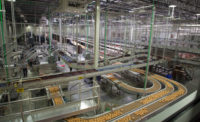Product Safety Device Maintenance Is Critical

There is no doubt that product safety devices (PSDs) have helped make the food and beverage industry safer. Devices such as sifters, strainers, magnets and foreign-matter detectors have been used for many years to remove foreign matter from product streams. However, none of these devices can be installed and then forgotten about and expected to continue working properly. All of them need some level of maintenance to keep them in good operating condition.
Sifters/Strainers
Sifters and strainers are used to filter foreign material out of a product stream. Sifters are for dry ingredients and may have some type of shaker or vibration mechanism to keep product flowing. Strainers are used on liquids and do not typically need anything more than the normal flow to function. These devices work basically the same way—product is passed through a mesh screen of a certain size to remove particles larger than the mesh. They have to be designed for the product type and flow rate, and should use a mesh slightly larger than the product particle size. Systems may be designed with several devices of different sizes that serve different purposes.
As an example, a mill will typically have a coarser-mesh sifter early in the process to pull out larger foreign matter, such as stalks, rocks and other field-related items, primarily to protect the equipment that will later grind the grain into smaller particles. A much smaller mesh usually will be used right before packaging to ensure that there is no foreign matter in the final product.
Sifters and strainers need relatively little maintenance. They must be checked periodically to ensure that they are undamaged and properly in place. These checks should be documented with the date and time. Any damage or evidence that they are not seated properly means that something may have passed through that was not intended. Follow-up on the product that was produced since the last good check should be conducted to ensure that there is no contamination. The frequency of checks should be determined by how much product the facility is willing to put at risk. A replacement screen should always be kept on hand to prevent unnecessary downtime in case one of these devices becomes damaged.
If sifters or strainers are used for bulk unloading, they should be checked after each unload. This provides two benefits. First, if foreign matter is found, the supplier or transport company can be held accountable. Second, if a damaged screen is found, the amount of product at risk is reduced.
Magnets
Magnets are used in different parts of the process for similar reasons as sifters and strainers. Unlike sifters and strainers, however, magnets will remove only ferrous metal, not other foreign material. They need a little more attention and care than sifters and strainers. Their design, strength, type and size are dependent on several factors:
Product type. A thick, viscous product will require a stronger magnet than a lightweight, free-flowing product.
Flow rate of the product. The magnet must be able to capture and hold the metal against the flow of the product. It is harder for a magnet to remove and retain metal from a fast-moving product than a slower-moving one.
Amount of metal that is expected to be captured between checks. If the amount of metal expected is high (e.g., grain from a field is expected to have more metal than flour), then the magnet’s holding power will need to be higher. If checks will not be done frequently, a stronger magnet may be needed to account for this. If the magnet is overwhelmed with metal, some either will not be pulled out, or will get knocked loose by the product flow.
Once a magnet has been installed, it must also be checked and cleaned periodically, and these checks should be documented. Care is needed during cleaning to ensure the magnet is not damaged. Since the magnets themselves are usually brittle (they are typically encased in stainless steel for protection), they should never be dropped or struck. Magnets are also susceptible to damage from excessive heat. Follow the manufacturer’s instructions and include them in initial and refresher training for personnel who are handling magnets.
Magnets can also lose strength over time, either naturally—which is typically a slow loss—or through damage, which can be very fast. So, regular pull tests should be conducted to check magnets’ attractive force against their original strength. (Pull tests use a device with a piece of metal of a specific size and a meter that measures the amount of force needed to pull the piece of metal loose from the magnet.) These tests are probably only needed every couple of years to monitor how fast your magnets are decaying. If a magnet has been subjected to excessive heat (possibly from a fire) or has been dropped or struck, it should be pull-tested immediately.
By monitoring your magnets over time, you can predict when they will need to be replaced, and capital dollars can be budgeted in advance.
Foreign Matter Detectors (FMDs)
FMDs are devices that operate by creating an electromagnetic field and monitoring changes as product passes through it. A disruption of the field will be detected. The FMD must be calibrated for the specific product type, and can be designed to scan product either before or after packaging. The FMD should be connected to a reject device to prevent any material that trips the FMD from continuing downstream. Some FMDs operate similar to sifters/strainers and magnets early in a product stream to allow for removal of foreign matter that might damage equipment. Others are placed directly before or after the product is packaged as a final quality check.
FMDs will not pick up all foreign objects, just those that disrupt the electromagnetic field. They have an advantage over magnets in that they will identify stainless steel. However, the size of the stainless steel particles that FMD will detect is typically larger than that of ferrous metals since stainless steel disrupts electromagnetic fields less.
FMDs need the most care and maintenance of all of the devices discussed. Calibration/validation/verification, training and interference issues are all essential considerations.
Calibration/Validation/Verification
Initial setup of the FMD is critical to ensure that it will accurately detect foreign matter. The device must be carefully calibrated to the product by the manufacturer’s technical representative. Make sure to follow the manufacturer’s requirements in terms of metal-free zones and vibration elimination. An alarm counter should be included in the setup.
Once the calibration has been completed, a regular program of validation must be implemented to ensure the device continues to function properly. Typically, a coupon containing a specific size sphere of stainless, non-ferrous or ferrous metal is run through the FMD with the product. The device should detect the coupon and sound an alarm, and the reject should capture the coupon and associated product. If all of these do not happen, then maintenance will need to troubleshoot the issue. All of the metal types must be run to validate the device’s ability to detect each type. Stronger programs will periodically validate each coupon three or more times in a row as a more stringent challenge of the device.
The program often will also use more frequent verification without product running. This is especially common when the device is positioned immediately before packaging, and using a coupon in the product stream puts the coupon in the package, resulting in having to open the package to retrieve the coupon. A plastic wand containing either ferrous or non-ferrous metal on one end and stainless steel on the other is inserted into the FMD aperture. The alarm should sound, but without product running, the reject mechanism cannot be checked.
A log for each FMD is needed to record each alarm, including checks. The findings of the alarm must also be recorded, including any false alarms. Any findings of foreign material should be investigated immediately to determine the source. If it is determined that the source is associated with the production equipment, corrective action can be conducted on that equipment to eliminate the source.
The logs should be reviewed periodically for recurring findings, including false alarms and missing information. Recurring appearances of foreign matter originating from the equipment suggest the true source has not been identified or corrected. False alarms are an equally important issue. They point to some type of interference, which will be discussed later. If the false alarms continue, what typically happens is that the sensitivity of the FMD is reduced, which may make it unable to detect some foreign matter. Missing information may point to a lack of investigation by the responsible individuals.
Training
Training is needed for the equipment operators who will be monitoring the FMD. They need to know how to respond to an alarm, how to properly log the information and what procedures to follow. Whoever will be doing validation and/or verification checks also needs to be trained. They need to know how to properly conduct the checks, how to follow up on failed checks and how to properly log all checks.
Training is also absolutely critical for maintenance personnel. FMDs should be on a preventative maintenance (PM) program as recommended by the manufacturer. Maintenance personnel need to know how to properly conduct the PM, and how to troubleshoot problems. They may need special equipment to diagnose issues, or an outside technician may be brought in. The adjustment controls should be secured so that only authorized personnel can make changes. More advanced training is usually offered by the manufacturer and might be desired to develop in-house expertise.
What often happens if training is not kept up, or if the adjustment controls are not secured, is that plant personnel end up lowering the sensitivity of the FMD in reaction to excessive false alarms and an inability to properly identify the cause. The problem is that reducing its sensitivity may well cause the FMD to fail to pick up some foreign matter.
Training for operational, quality assurance and maintenance personnel should be ongoing. Annual refresher training for all personnel is needed to keep the program current. Monitoring turnover, especially of maintenance personnel, is important to ensure no knowledge gaps develop.
Interference
Since FMDs are sensitive devices, many things can interfere with how well they work (see sidebar Examples of Interference ).
Manufacturers will dictate a minimum metal-free zone for installation of the device. Since FMDs operate by creating an electromagnetic field, they need a certain space free of any metal that could warp that field and cause the FMD to be less sensitive than it was designed to be. Other installation concerns are the routing of electronic cables. If the cables are too close or are not properly shielded, they may interfere with the device.
Another common source of electrical interference is radios. Maintenance technicians have been observed transmitting on their radios while standing next to an FMD, immediately causing alarms and rejects. Make sure radios are not placed too close to the machine and personnel using radios know to keep their distance.
Vibration is another common form of interference. During installation, care is needed to eliminate or dampen vibration from equipment. Procedures should be developed and personnel trained to ensure they are not causing vibration near the FMD. When vibration-dampening pads are used, regular monitoring is needed to ensure they have not been lost during cleaning or maintenance activities.
When troubleshooting excessive false alarms, sources of interference should be at the top of the list. Here are some questions that can be asked during troubleshooting:
• Have there been any changes to the surrounding equipment or structure recently?
• What possible sources of electrical interference are nearby? Has new electrical equipment been installed recently? Was someone using a radio nearby?
• What sources of vibration are nearby? Has something changed? Was equipment being moved nearby? Are all vibration-dampening pads in place and in good repair?
• What other activities were occurring nearby during the false alarms (cleaning, maintenance, construction, etc.)?
Summary
Product safety devices have proven to remove foreign matter from product streams for many years. They protect both production equipment and the consumer. But they are not “install and forget” devices. They need regular monitoring and maintenance to continue functioning as designed. With the proper care, they will provide the food and beverage industry continued removal of foreign material.
R. Mark Davis is the manager of sanitation for Quaker-PepsiCo, a position he has held for two years. His 12 years with PepsiCo includes 10 years with the Frito-Lay North America (FLNA) division, where he became certified as one of its Sanitation Division Expert Trainers. He is a member of IAFP and has a B.A. in Communications from the University of Dayton. He can be reached at mark_r_davis@quakeroats.com.
Examples of Interference
 A plant was troubleshooting excessive false alarms. The cause was determined to be an extra-long FMD cable that was the standard length ordered by the company. The extra cable length was coiled near the FMD, causing interference. The correction was to shorten the cable.
A plant was troubleshooting excessive false alarms. The cause was determined to be an extra-long FMD cable that was the standard length ordered by the company. The extra cable length was coiled near the FMD, causing interference. The correction was to shorten the cable.
In another example, carts used to transport weigher hoppers to a nearby equipment washer were causing excessive vibration, leading to false alarms. The plant adjusted procedures to stop using these carts during production. This change reduced the ability to use the washer during flavor changeovers, however. The plant is still searching for a solution that will allow the washer to be used during flavor changeovers without causing excessive vibration.
Looking for a reprint of this article?
From high-res PDFs to custom plaques, order your copy today!








